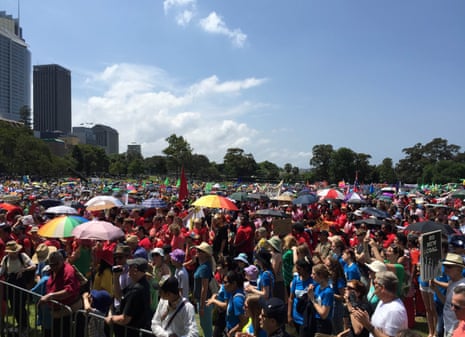Helpful reminder for those marching in Sydney right now:
Quick PSA for Sydney: there are water stations dotted around. You should drink some #climatemarch #peopleclimate pic.twitter.com/JC6NySchf8
— GetUp! (@GetUp) November 29, 2015
Helpful reminder for those marching in Sydney right now:
Quick PSA for Sydney: there are water stations dotted around. You should drink some #climatemarch #peopleclimate pic.twitter.com/JC6NySchf8
— GetUp! (@GetUp) November 29, 2015
The crowds in Sydney have observed one minute’s silence to reflect upon those most affected by climate change, ended by the sounding of a didgeridoo.
Many of those there are saying that the Domain – no small space – is almost full to capacity.
Once the speeches and songs are finished, the rally is set to march through the streets of Sydney in colour-coordinated blocks:

Although it is very hot in Sydney today, with protesters – those who weren’t canny enough to bring their umbrellas – seeking out whatever shade they can find, activists are well aware that the real front line against climate change lies further west, in the Pacific islands.
A good primer on that situation is this report by my colleague Oliver Milman:
The cause for concern is clear – Nasa recently reported the world’s sea level has risen nearly 8cm since 1992, with the Pacific experiencing a more rapid increase than other oceans.
A rise of around a metre by the end of the century now looks likely. For low-lying islands in the Pacific, this means coastal erosion, saltwater seeping into precious rainwater catchments and ruined crops.
Meanwhile, rising temperatures will heighten the risk of diseases, including those carried by mosquitos. Cyclones are expected to become more severe. The World Health Organisation estimates climate change will cause around 250,000 deaths globally between 2030 and 2050.

My colleague Ben Doherty is in Sydney’s Domain, sheltering from the sun and hearing from Professor Tim Flannery, one of Australia’s leading climate change activists, who says today “looks like the largest climate march ever in Australia”.
The Paris talks, he said, are the last chance to save “many things we care about, like the Great Barrier Reef … We are coming to this issue very late.”
There are no easy fixes to the climate problem, he warned, but Australia needs to close down polluting industries and dependence on fossil fuels:
We are meeting in the home city of the Australian prime minister. We need to send a very powerful message to him: do what the people demand.
He said the Australian people would not accept anything less than a successful outcome at Paris.

It was a very peaceful, family-oriented affair in Canberra, as people brought their children to march with them from Parliament House to the tent embassy, near Old Parliament House.
Police estimate around 3,000 people showed up, while protesters think the number is closer to 6,000. Canberrans are fairly cautious about protesting, as many are public servants and are often reluctant to make political statements.
One of the coordinators of the event, Emma Robinson from the Conservation Council, said she was not surprised that so many showed up in the capital.
“Climate change is and has always been everyone’s business,” she said.
The event was staffed by about 80 volunteers, most of whom are Canberra locals who are part of the Conservation Council.
Former chief scientist of Australia, Penny Sackett, said that protests like Sunday’s make people feel as though they are taking action on climate change.
“People can become discouraged because it appears as though [political] change does not happen swiftly enough,” she told Guardian Australia.
She said the march was a message from voters to world leaders who are about to meet on climate change in Paris: “We’re watching.”
The Canberra Times now estimates there are more than 5,000 people taking part in the march there.
This gives you a better ideas of the numbers marching down from Parliament House, #Canberra. #peoplesclimate #cbr pic.twitter.com/6aNEeVMYVQ
— Richard Tuffin (@RichardTuffin) November 29, 2015
Attendance numbers are always a tricky thing with marches, with totals from organisers and police often varying wildly.
Police estimates for Melbourne, for example, put the crowd numbers by the end of Friday night at about 40,000, but organisers said 60,000 turned out.
Similarly, estimates for Brisbane on Saturday came in at between 5,000 and 10,000.
We’re yet to hear estimates for the Sydney crowd but organisers already seem overwhelmed by the numbers who have shown up so far.
An enterprising cyclist at the Adelaide rally:

Meanwhile, some Sydney marchers seek out the shade:
Too hot out in the middle! #peoplesclimate pic.twitter.com/Y7ejzXipdt
— Paddy Manning (@gpaddymanning) November 29, 2015
The Sydney rally is underway, with thousands already in attendance and many more still arriving:
The power is ours! Yehhhh Sydney! #peoplesclimate #climatemarch pic.twitter.com/BqqlzByULb
— Greenpeace Aus Pac (@GreenpeaceAustP) November 29, 2015
Huge #greens turnout for #PeoplesClimate!! Rally starting now. pic.twitter.com/laNbMg50Y4
— Greens NSW (@GreensNSW) November 29, 2015
Ben Doherty is now in the Domain, from where the march is leaving, and reports “massive numbers”:
Much more multi-coloured than the Hyde Park beginnings, people in all manner of colours, lots of associated causes: anti-nuclear, church groups, refugee groups.
One guy has a mallard on his head, and a tree growing out of his backpack.
Sydney lord mayor Clover Moore tells the crowd that COP21 in Paris will be the most important meeting of our lifetime.
“On it depends the future of our planet,” she says.
Hello Hobart! Tasmanian marchers are also assembling, with a minute’s silence for Paris, which is hosting this week’s climate talks, but – after the terrorist attacks of 13 November – will not be holding its own climate march:
A min of silence for #Paris & imagining a clean, compassionate future in #Hobart at #peoplesclimate march #cop21 pic.twitter.com/p57G5JG1Yz
— Claire Havens (@ClaireHavens) November 29, 2015
My colleague Ben Doherty is with the Sydney marchers and sends this dispatch from the start line:
At the Sydney march, there are red shirts everywhere. Solid, if not yet spectacular numbers are gathering at the north end of Hyde Park, and marching into the Domain in bright sunshine.
Labor deputy leader Tanya Plibersek, who brought her own phalanx of rosily-attired Young Laborites, gave a rangy press conference at which she rejected the ‘heroic’ label Malcolm Turnbull affixed to Labor’s emissions targets (it wasn’t meant as a compliment, Plibersek seems to suspect).
She condemned Turnbull for “stopping off on the way to Paris to lecture other heads of government to do more on climate change, while he is doing less”.
Plibersek said Labor’s targets would require significant change in Australia, but that the country had already seen, and embraced, change aimed at reducing emissions.
She said the $1m Australia has offered to contribute to the Commonwealth’s new Climate Finance Access Hub (established at the CHOGM meeting in Valetta) was “pathetically puny”.
The hub will be set up to help small island nations vulnerable to climate change access global funds for mitigation and adaptation.
Plibersek said Australia, given its role as a leader in the Pacific region, needed to do more to help its neighbours, some of whom face “an existential threat” from climate change.
Comments (…)
Sign in or create your Guardian account to join the discussion